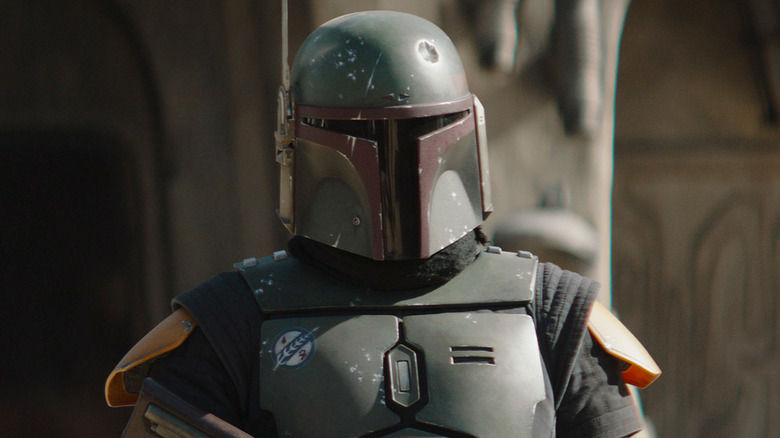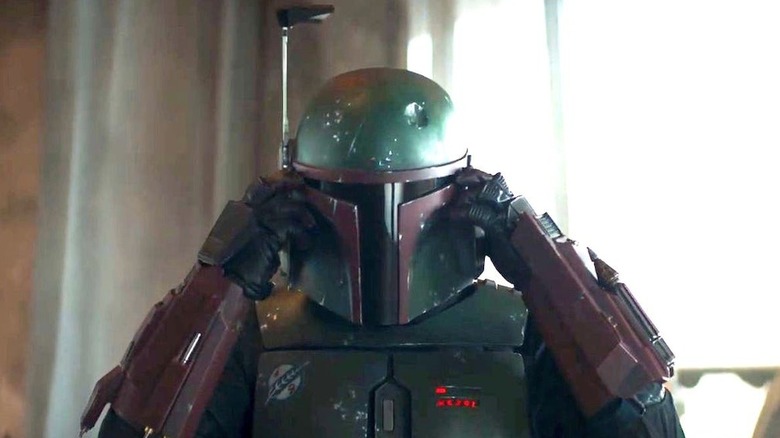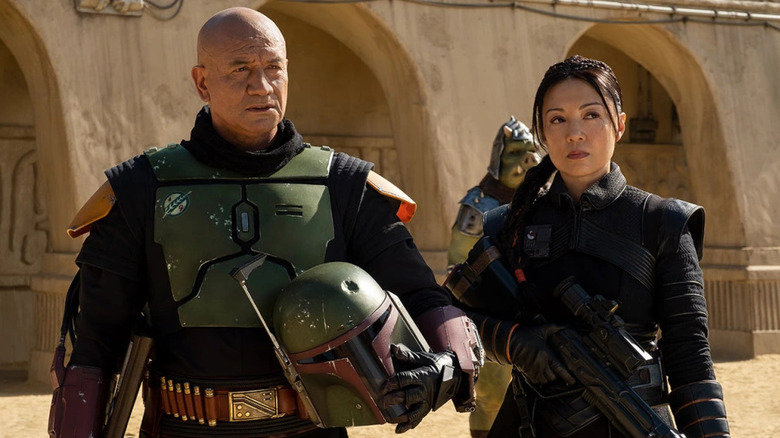Star Wars: The Meaning Of Boba Fett's Armor Colors Are Completely On Point
Boba Fett originally appeared in "Star Wars: Episode V – The Empire Strikes Back" as one of six bounty hunters assembled by Darth Vader to hunt down the crew of the Millenium Falcon. In truth, Boba Fett doesn't play a huge part in the film. When he is first introduced, he doesn't even have a name. Despite Boba Fett playing a relatively small role, fans are obsessed with him, mostly thanks to his iconic look.
The popularity of this character eventually leads to Disney+ reintroducing Boba Fett in "The Mandalorian" and then giving him his own show, "The Book of Boba Fett." His iconic armor goes through various stages from freshly painted to battle-worn, but in every one of Boba Fett's appearances, he's seen wearing the same color scheme — predominantly green with red trim and gold accents.
Boba Fett's chosen color scheme has evolved as much as he has over time. According to Mandalorian culture, every color that Boba Fett wears has a significant meaning. For Boba Fett, red is meant to honor his father, Jango Fett, and green stands for the importance of duty. Even the gold accents have a deeper meaning, which usually represents a desire for vengeance.
Boba Fett's color scheme is a deliberate message
Boba Fett's color scheme isn't the most attractive combination of colors, but it has become such an iconic staple of his character that it's hard to imagine him wearing anything else. Just as Din Djarin has become known for his shiny chrome armor, Boba Fett's armor always stays in a similar color scheme, no matter how many times it's repainted.
In Mandalorian culture, red is meant to honor the wearer's parents. A huge part of Boba Fett's backstory is his relationship with Jango Fett. Jango is the person the clones are based on. One of his stipulations for his cooperation is being given a clone that will age at a normal rate. That clone is Boba, who he treats like a son.
Jango's death at the hands of Mace Windu (Samuel L. Jackson) shapes Boba for many years, so he always wears red to honor the bond he shares with his father. The gold in his armor also represents his desire for vengeance for his father's death.
Likewise, green, which is the main color in his armor, is meant to represent duty. Although Boba has been a bounty hunter for many of his appearances, he has also taken on some pretty important roles over the years. For instance, he serves as both a Journeyman Protector and the Mand'alor in "Star Wars Legends."
Boba's current run continues this mentality
Boba Fett's most recent appearance in "The Book of Boba Fett" still shows him acting with a sense of honor and duty. While he doesn't live within the realm of what's considered lawful, Boba is loyal, pays his debts, and feels strong connections with those who have done right by him.
The show addresses how Boba survives being eaten in the films. After escaping the Sarlacc, Boba is robbed and left behind by a pack of Jawas. Eventually, he's captured by a tribe of Tuskan Raiders and taken prisoner.
When one of their children finds themselves in danger, Boba saves the child, earning the respect of the Tuskan Raiders and his freedom. He becomes part of their tribe and chooses to live among them. Not only does he become one of them, as he learned their ways, he teaches them as well, helping them grow more powerful and reclaim control of their territory.
The show also elaborates on how he saves Fennec Shand's life and why she's become his right hand. It also explains why he helps Din. This emphasizes that while Boba might work outside the law, he does approach everything with a moral code of his own.
He's capable of empathy and doing right by people who deserve it. With Fennec's help, he even manages to take over Jabba's criminal empire on Tattooine. With this position of power, he makes the world more livable and safe for the people.


